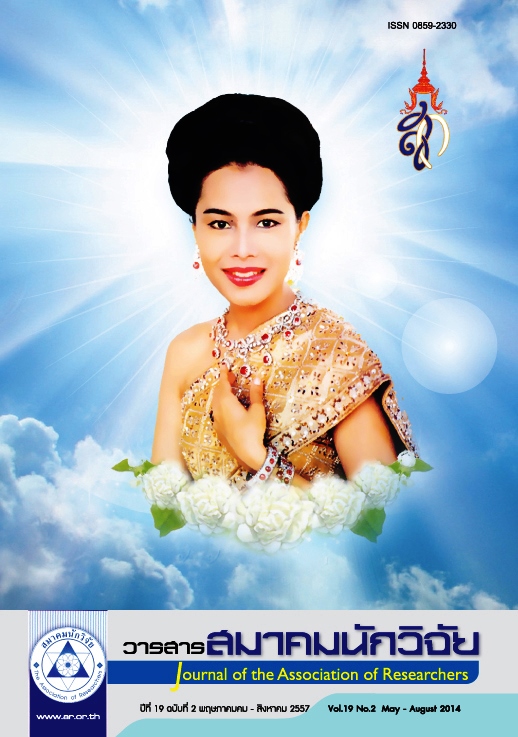knowledge management affective on human capital of small and medium enterprises (sme s) ceramic business in upper northern provices of thailand
Main Article Content
Abstract
This research aims to develop a causal model of Knowledge Management which affected a Human Capital of Ceramics Small and Medium Enterprises (SMEs) in the upper northern part of Thailand. A quantitative and qualitative research methods are applied in this research, and the samples, was 844 administrative staffs and employees of Ceramics SMEs Business. An descriptive statistics used for an analysis of data, frequencies, percentages, arithmetic means and standard deviations, on the inferential statistics, a correlation analysis and influential path analysis were applied in this research. The result found that a causal model of Knowledge Management which affected a Human Capital of Ceramics Small and Medium Enterprises (SMEs) in the upper northern part of Thailand conformed with an empirical data. A statistics of Chi-square goodness of fit =38.5, df 20, p-value = 0.00769, RMSEA = 0.033, GFI = 0.99, and AGFI = 0.98. A coefficient path of Human Resources Management and Knowledge Management variables are in strongly important level = 0.92, Human Resources Management and Human Capital, coefficient path = 0.33, and Knowledge Management and Human capital, coefficient path = 0.21 no statistical significant.
A Human Resources Management has a direct positive relationship with a Human Capital and Human Resources Management has a direct positive relationship with a Knowledge Management. Furthermore, a Human Resources Management and Knowledge Management are all related and have a direct positive relationship with a Human Capital
Article Details
บทความที่ปรากฏในวารสารนี้ เป็นความรับผิดชอบของผู้เขียน ซึ่งสมาคมนักวิจัยไม่จำเป็นต้องเห็นด้วยเสมอไป การนำเสนอผลงานวิจัยและบทความในวารสารนี้ไปเผยแพร่สามารถกระทำได้ โดยระบุแหล่งอ้างอิงจาก "วารสารสมาคมนักวิจัย"
References
ชฎาวีร์ คงเจริญถิ่น,อุรัมภา ขัตตินานนท์ และอดิสร จันทพิมพะ.(2550). การจัดการความรู้: กรณีศึกษาโรงพิมพ์ธนบัตรธนาคารแห่งประเทศไทย.การศึกษาค้นคว้าด้วยตนเอง บธ.ม.,มหาวิทยาลัยธรรมศาสตร์,กรุงเทพฯ.
ญาดา ประภาพันธ์.(2546).แรงงานสตรีด้อยทักษะ: การพัฒนาทักษะมนุษย์โดยผ่าน กระบวนการฝึกฝนอบรมและการศึกษากรณีประเทศไทย. มหาวิทยาลัยรามคำแหง,กรุงเทพฯ.ค้นเมื่อ 14 ธันวาคม 2554,จาก http://www.cmu.ac.th/search.php?page=3&keyword=&searchby=1&click
ณพศิษฐ์ จักรพิทักษ์.(2552).ทฤษฎีการจัดการความรู้. เชียงใหม่:มหาวิทยาลัยเชียงใหม่.
ธัญนันท์ สินชัย.(2551).การจัดการความรู้ของศูนย์ควบคุมโรคไข้หวัดนก กรมปศุสัตว์ กระทรวงเกษตรและสหกรณ์.วิทยานิพนธ์ ศศ.ม.,มหาวิทยาลัยรามคำแหง,กรุงเทพฯ.
วิเชียร ฤกษ์พัฒนกิจ.(2551).การจัดการความรู้ของบริษัทจดทะเบียนในตลาดหลักทรัพย์แห่ง ประเทศไทยกระบวนการพัฒนาทุนทางปัญญา.วิทยานิพนธ์ ปร.ด.,มหาวิทยาลัยรามคำแหง,กรุงเทพฯ
ศูนย์เครื่องเคลือบดินเผาลำปาง.(2555). เอกสารผู้ประกอบการเซรามิก.ลำปาง.
สุกฤษฎิ์ ลิ้มโพธิ์ทอง.(2550).การบริหารทรัพยากรมนุษย์เชิงกลยุทธ์ขององค์กรธุรกิจการผลิตเครื่องใช้ไฟฟ้าและ อิเล็กทรอนิกส์ในประเทศไทย.วิทยานิพนธ์ ปร.ด.,มหาวิทยาลัยรามคำแหง,กรุงเทพฯ.
สำนักงานคณะกรรมการพัฒนาเศรษฐกิจและสังคมแห่งชาติ.(2554).แผนพัฒนาเศรษฐกิจและสังคมแห่งชาติ ฉบับที่ 11 (พ.ศ.2555-2559) ค้นเมื่อ 24 ธันวาคม 2555,จาก http://www.nesdb.go.th/Portals/0/news/plan/p11/plan11.pdf
สุภมาส อังศุโชติ,สมถวิล วิจิตรวรรณาและรัชนีกูล ภิญโญภานุวัฒน์.(2551).สถิติวิเคราะห์ สำหรับการวิจัยทางสังคมศาสตร์และพฤติกรรมศาสตร์ : เทคนิคการใช้โปรแกรม Lisrel. กรุงเทพฯ:มิสชั่น มีเดีย.
อนุรักษ์ อาทิตย์กวิน.(2552).แนวทางการพัฒนาผลิตภาพโรงงานเซรามิกลำปาง.ดุษฎีนิพนธ์ตามหลักสูตรการจัดการดุษฎีบัณฑิตสาขาการจัดการธุรกิจ.บัณฑิตวิทยาลัยมหาวิทยาลัย ราชภัฏสวนดุสิต.
Afiouni,F.(2007).Human resource management and knowledge management: road map toward improving organizational performance,Journal of American Academy of Business Cambridge, 11(2),124-130.
Andreou,A.N.,Green,A.&Stankosky,M.(2007).A Framework of intangible valuation areas and antecedents.Journal of Intellectual Capital, 8(1),52-75.
Barney,J.(1991).Firm resources and sustained competitive advantage.Journal of management, 17(1),99-120.
Benavides-Espinosa,M.D.M.&Roig-Dobon.S.(2011).The role of entrepreneurs in transfering knowledge through human resource management and joint venture.International Journal of Manpower, 32(1),117-131.
Bontis,N.,&Serenko,A.(2007).The moderating role of human capital management practices on employee capabilities.Journal of Knowledge Management,11(3),31-51.
Carmeli,A&Tishler,A.(2004).Resources, Capabilities, and the performance of industrial firms: A multivariate analysis.Managerial and Decision Economics.Published online in Wiley Interscience,299-315.
ChiehHsu,I.(2008).Knowledge sharing practices as a facilitating factor for improving Organizational performance through human capital:A preliminary test.Expert Systems with Applications, 35(3),1316-1326.
Darroch,J.(2005).Knowledge management,innovation and firm performance. Journal of knowledge management, 9(3),101-115.
Davenport,T.H.,&Prusak,L.(1998).Working knowledge: How organization manage what they know. Boston: Harvard Business School Press.
Ducharne,L.M.(1998).Measuring intangible investment: main theories and concepts.Statistics Canada&OECD.
Filius,R.,Fong,F.A.&Roelofs,E.C.(2000).Knowledge management in the HRD office: a comparison of three cases.Journal of Workplace Learning,12(7),286-295.
Gold,A.H.,Malhotra,A.,&Segars,A.H.(2001).Knowledge management:An organizational capabilities perspective.Journal of Management Information System,18(1),185-214.
Lindsey,K.(2002). Measuring knowledge management effectiveness: A task-contingent organizational capability perspective.Proceeding of the 8th Americas Conference on Information System,2085-2090.
Liu,P.L.&Tsai,C.H.(2007).Effect of knowledge management systems on operating performance:An empirical study of hi-tech companies using the balanced scorecard approach.International Journal of Management, 24(4),734-743.
Lopez,V.A.(2001). Anoverview review of the resource-based view (RBV)of the firm,drawing on recent Spanish management research.Irish Journal of Management, 22(2)105-120.
Munro,
B.
H.
(2005).
Statistical method for healthcare research
(5 th ed). R.R.
Donnelley
Crawfordsvill
:
United
State
of
America. Oltra,
V.
(2005). Knowledge
management
effectiveness
factor:
the
role
of
HRM.
Journal of Knowledge Management, 9(4),
70-
86. Pastor,
I.
M.
P.,
Santana,
M.
P.
P
&
Sierra,
C.M.
(2010).
Managing
knowledge
through
human
resource
practices:
empirical
examination
on
the
Spanish
automotive
industry. The International Journal of Human Resource Management, 21(13),
2452-
2467. Penrose,
E.T.
(1959). The Theory of the growth of the firm.
New
york:
John
wiley. Schiemann,
W.
A.
(2007).
Measuring
and
managing
the
ROI
of
human
capital.
Cost
Management, 21(4),
5-15. Seleim,
A.,
Ashour,
A.,
Bontis,
N.
(2006).
Human
capital
and
organizational
performance:
a
study
of
Egyptian
software
companies.
Management Decision, 45(4),
789-801. Shih,
H.A
&
Chiang,
Y.H
.(2005).
Strategy
alignment
between
HRM.KM,
and
corporate
development.
International Journal of Manpower, 26(6),
582-
603. Takeuchi,
H.
&
Nonaka,
I.
(1986).
The
new
new
product
development
game.
Harvard Business Review, 64(1)
,137-146
(Jan/Feb),
reprint
no.
86116. Thite,
M.
(2004).
Strategic
positioning
of
HRM
in
knowledge
–
based
organizations.
The
Learning
organization, 11(1),
28-44. Wan,
H.L.
(2007).
Human
capital
development
policies:
enhancing
employees’
satisfaction. Journal
of
European
Industrial
Training,31(4),
297-322. Wernerfelt,
B.
(1984).
A
Resource-base
view
of
the
firm.
Strategic Management Journal, 5(2),
171-
180. Yahya,
S.
&Goh.
W.
K.
(2002).
Managing
human
resource
toward
achieving
knowledge
management.
Journal of Knowledge Management, 6(5),
457-
468. Zikmund,
W.
G.
(2003).
Business Research Methods.
Ohio
:
United
States
of
America


